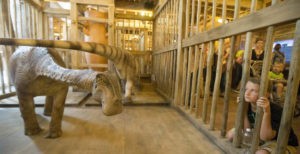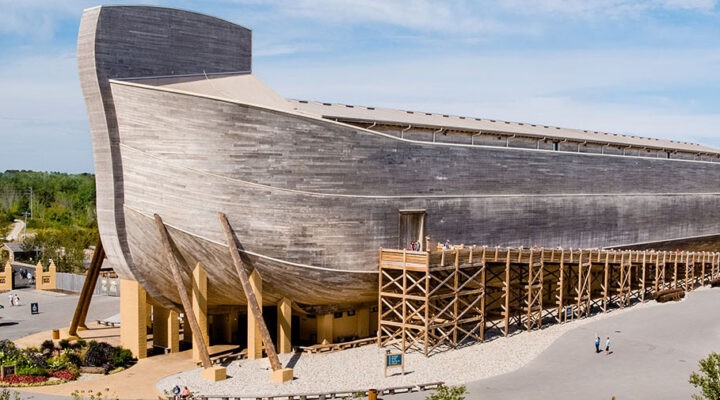Creationism is big business, based on the apparent success of the Ark Encounter and Creation Museum in Northern Kentucky.
A recent news release from the controversial enterprise reported plans to welcome the 10 millionth visitor this week. The Creation Museum opened in 2007, and the Ark Encounter opened in 2017.
The news release touted a multimillion-dollar economic impact on the region just south of Cincinnati from all those conservative Christian visitors staying in hotels and eating meals in restaurants over the past 15 years.
But wait, there’s more to come.
 In addition to the existing 510-foot-long replica of Noah’s Ark, the Creation Museum has announced the coming attraction of an “ark-themed carousel, custom-built in Italy.” This indoor, all-weather carousel will include a variety of animals creationists believe were on Noah’s Ark, including dinosaurs.
In addition to the existing 510-foot-long replica of Noah’s Ark, the Creation Museum has announced the coming attraction of an “ark-themed carousel, custom-built in Italy.” This indoor, all-weather carousel will include a variety of animals creationists believe were on Noah’s Ark, including dinosaurs.
Specifically, advance publicity shows the carousel including a hand carved Quetzalcoatlus, which is believed to have been one of the largest known flying animals of all time. Modern science dates this dinosaur to the Late Cretaceous period, meaning it lived 72 million to 66 million years ago.
Another dinosaur to be featured on the carousel is the Tyrannosaurus rex, which modern science dates to the Upper Cretaceous period, 68 million to 66 million years ago.
Creationism — as taught by the Creation Museum and its founding organization, Answers in Genesis — holds to a young earth view of creation, based on a literal reading of the Bible from Genesis forward. According to this, the earth is only 6,000 years old, and some dinosaurs coexisted with humans — a view not held by any scholarly scientists today.
While popular with some conservative evangelicals, creationism has no support in mainstream science. A 2019 Gallup Poll found that 40% of Americans say they believe in creationism, with the likelihood of holding that belief corresponding heavily toward lower levels of education.
In a review of the Creation Museum when it first opened, Daniel Phelps, president of the Kentucky Paleontological Society, labeled the tourist attraction “the Anti-Museum” and said it features “absurd claims.”
“Some of the claims, such as the vegetarian Tyrannosaurus and other carnivores are so absurd one wonders how many of the children (or adults) are really going to accept it,” he wrote. “There is a lot of scientifically valid information available on dinosaurs in books and on the internet. Creationists are really going to have to go to great lengths to shelter their children from this information.”
Phelps envisioned the museum and life-size ark appealing to home-schooling parents but also wondered if its presence could put a damper on the teaching of accepted science in the region’s schools. He called the teaching of Answers in Genesis “outrageous and remarkable pseudoscience.”

A masterplan for the various elements of the Answers in Genesis theme park in Northern Kentucky.
Answers in Genesis mixes a variety of conservative theological beliefs along with its views on creation. Thus, another coming attraction is a Tower of Babel attraction that the news release said “will tackle racism issues” by “showing how all people groups have developed from one biological race.” Also planned is “a massive indoor scale model of what Jerusalem may have looked like at the time of Christ.”
The existing Creation Museum is a 70,000 square foot facility described as a “walk-through Bible history,” including “a chronological walk through the Bible from Genesis to Revelation, animatronics, a planetarium, a special effects theater, a 1,000-seat auditorium, nature trails and petting zoo.” The Ark Encounter is a separate walk-through space with exhibits designed to show what life would have been like on Noah’s Ark.

In Northern Kentucky, visitors to the “Ark Encounter” at the Creation Museum see baby dinosaurs in wooden cages aboard a replica of Noah’s Ark.
In its most recent IRS filings available online, Answers in Genesis (including the Ark Adventure and Creation Museum) reported annual gross receipts of $51.7 million and assets of $77.6 million. The report, based on 2018 data, shows $21 million in gross receipts from admissions, merchandise sold or services performed.
Although Answers in Genesis is a nonprofit organization, the Ark Encounter and Creation Museum are classified as for-profit businesses and are subject to local property taxes — which has been a matter of ongoing regional dispute. The museum’s news release said the Ark Encounter has paid nearly $4.9 million in property taxes and another $1.7 million toward a local safety assessment fee.
But by classifying its attractions as for-profit, Answers in Genesis received millions of dollars in tax breaks from the city, some of which are contested to this day.
Answers in Genesis also is obligated to collect sales tax on ticket admissions to the attractions, which run from $25 to $100.
The organization says the tourism it generates in the region “has added many tens of millions of dollars into the state and local treasuries, plus has seen the construction of several new hotels to meet guest demand.”
With 92% of visitors to the creationist attractions coming from outside Kentucky, the demand for hotel rooms is so great in the summer that “no hotel rooms are available within an hour’s drive of the ark.”
Answers in Genesis says the parent organization, the Ark Encounter and Creation Museum together employ 1,000 staff, including full time, part time and seasonal staff.
On summer Saturdays, the Ark Encounter reportedly draws more than 9,000 visitors and the Creation Museum draws 4,000.
Related articles:
Christians and climate change: A chance to take the Bible seriously | Analysis by Chris Conley
Judge OKs tax break for Ark park
Were there baby dinosaurs on Noah’s Ark, and how does that relate to COVID?


